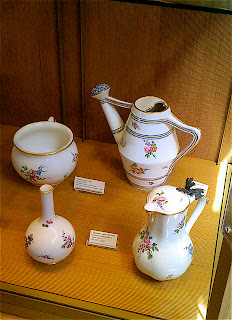Our mouths fell open in the very first gallery, when we came face to face with this giant, gleaming white urn. For scale, check the figure of the man in the lower left back of the photo.
This entire gallery was devoted to enormous, stunning urns of every shape and from every era, going back to the 18th century, when the factory had its beginnings, first in 1738 at the Chateau Vincennes (where the kings of France lived for many years) and then to this site in Sèvres in 1753, where it was run under the royal monopoly of Louis XV.
Over the centuries, designs, colors and techniques produced an extraordinary array of these urns...from this 18th century example...
...to this beauty on the left, designed by Hector Guimard, whose Art Nouveau designs grace so many metro stations in Paris...
...and to this portrait of snarling tigers from the Art Deco period.
Being from the Bay Area, we neither of us could imagine such a collection being displayed so casually. The merest thought of an earthquake set our teeth on edge! We chatted with the museum guard about this, who was most amused. No, Madame, he assured us, that is not a problem here! He began to show us his particular favorites in the room, including this ornately gilded one, made during Napoleon's time, and featuring the same giant white urn that stands in the centre of the room, here reproduced on the decorative panel in the middle. He then put his hands on the vase, and turned it slowly on its base, explaining that many of them were made with a built in turning axle in the inside of the vase, so that they could be safely turned, and all views appreciated. He even allowed me to try, checking first that no-one else was in the gallery, and whispering that it was just "entre-nous, Madame"! (I wondered, for a moment, if Napoleon's hands had turned this very vase...)
Moving into the adjacent galleries, we strolled among the displays, all of them on a somewhat more manageable scale! Even so, the thought of watering my garden with this delightful porcelain watering can, made me smile.
As we meandered through the rooms, I was struck at what an important role porcelain (and paintings and other art forms as well, of course), played in recording life at the time.
With none of the modern means of capturing images, it fell to these artisans to leave lasting examples of fashion, theatrical figures...
...military battles, such as these plates depicting Russian soldiers on the eastern front...
...even guilds, such as this printing press shop...
...and this confectioner's atelier. It was like looking at 18th century photo albums!
Instead of having their portrait painted on canvas, some of the landed gentry chose to have their likeness reproduced on tea cups, and their stately homes on fine china plates.
I particularly liked these purely decorative figures, so full of movement and joy!
As well as all the ornamental pieces, there were, of course, dozens and dozens of examples of exquisite "utility" pieces, like this classic Sèvres serving tray.
And this fabulous tureen with lions' heads for handles.
Really, though, at the end of the day, I decided that one of the joys of these pieces, whether you are Catherine II of Russia, with your own personalised china...
...or you and me, sitting down to dinner at home -- one of the joys is that when you eat off a pretty plate, the food always tastes better!
So, I came away from the museum appreciating all that we had seen, but also being grateful for the good taste and generosity of parents and grandparents in passing on their treasures to their children. Having admired all these wonderful pieces, I will have an even greater appreciation of my own "best" china at home!
Before we left, we had a quick look at the buildings behind the museum, where Sèvres pottery is still made today. Based on the prices we saw in the gift shop, it is still a "luxury" item!
Right next to the museum, we noticed an overhead tramway system, the T-2, which runs around the the city on the outer edges.
So, we jumped on board and rode around the south-west edge of Paris, enjoying the views out of the glass doors and huge windows. We transferred somewhere in the 15th arrondissement onto the #39 bus, which took us clear across the city and dropped us at our front door!
Hooray for the beauty of Sèvres Porcelain, and for the outstanding French public transportation system!
À bientôt!






















As Matthew knows, check out Dalva Brothers in NYC. You can touch them all. I am not sure about the huge vases and urns. What a great experience. Go Giants.Pablo is back!
ReplyDeleteThis reminds me of A S Byatt's recent novel THE CHILDREN'S BOOK, which has a lot to do with fine pottery making and features large artistic vases like the ones you show. Thank you for giving us a tour of the real thing!
ReplyDeleteYes, I too think a meal tastes better off of pretty porcelain.
ReplyDeleteSomething to do with the appreciation and anticipation.
From Mixing bays to gift shop the Wedgwood tour is four miles long!
What a wonderful tour you had and gave us.
Now, Royal Derby or Booths for a morning cuppa?
You may also find the Gobelin museum worth a visit. They periodically offer tours of the factory, continuing in daily operation (since the 1600s sometime.
ReplyDeleteWes S